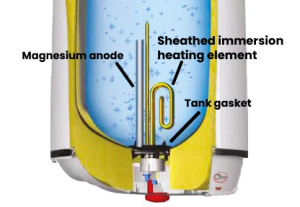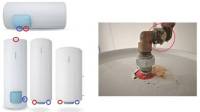If it’s a continuous leak, you should obviously shut off the water supply to your water heater.
It should be noted that some leaks are repairable, and some parts can be replaced (tank gasket, anode, Flange with heating element, etc.). Only a leak in the enamelled tank requires the complete replacement of the water heater.
Water heater with a sheathed heating element:
If water traces are located at the hydraulic connections (cold water or hot water)
A plumber must intervene to restore the seal.
Remember to periodically check the tightness of the water connections.
For a vertical floor-standing model, if water or rust traces are located at the lower part of the unit:
· Check that the safety valve does not splash the water heater casing during operation.
· If necessary, adjust the orientation of the air gap walls of the siphon to prevent splashes from the safety valve onto the tank.
It is important to note that these 'rust' marks are not caused by a leak in the tank. They will affect the aesthetic appearance of the unit without compromising its lifespan and cannot be covered under warranty.
If water traces are located near the cover
Turn off the power supply and contact your professional, who will determine which parts need to be replaced.
Here are some tips to help prevent unexpected issues:
- Make sure the room where the unit is installed is well-ventilated to avoid condensation forming on the tank casing.
- Check that the safety valve does not discharge water onto the water heater.
- Regularly inspect the hot and cold water connections for leaks.
Preventive maintenance to be carried out by your installer:
· In areas with very hard water, the water heater should be descaled every two years. This maintenance is especially important for models with a sheathed heating element.
· In areas with soft water or when a water softener is used (always set above 8°f), it is essential to check the magnesium anode every 2 years and replace it if its diameter is less than 10 mm.




